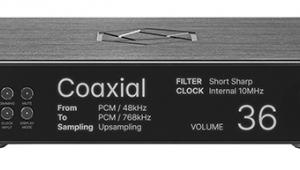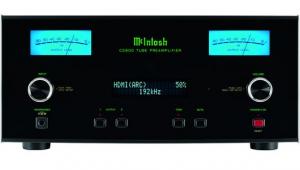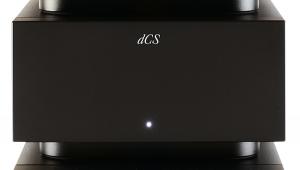Dcs Scarlatti Upsampler/dac (£6500/£12000)
The last time I was fortunate enough to have a dCS upsampler at home it was the Purcell, which was limited to upsampling PCM to PCM. Since then dCS has become a staunch advocate of DSD – the 1-bit, 2.8224MHz coding system used in SACD – and so the Upsampler half of the Scarlatti pairing here (the other being the Scarlatti DAC) offers upsampling to either PCM or DSD. It’s the user’s choice, with dCS’s preference being the latter.
Data can be transferred between the Scarlatti Upsampler and DAC in various ways. DSD data is carried, encrypted, via a Firewire (IEEE 1394) interface. Twin AES3 (aka AES-EBU) balanced outputs/inputs are available via XLRs, each of which can carry 24-bit PCM at up to 96kHz singly, or up to 192kHz in dual mode. Two unbalanced S/PDIF outputs/inputs via phono or BNC connectors also provide for up to 24/96 PCM but cannot be combined to support 176.4 or 192kHz sampling rates. An SDIF-2 interface is also available via twin BNCs which likewise supports up to 24/96. Word clocks are synchronised via a standard 75ohm BNC interface.
A USB CONNECTION, TOO...
In addition to its upsampling duties, the Scarlatti Upsampler expands the input capabilities of the DAC in one very important way. In addition to the AES3 inputs on XLR and S/PDIF inputs on phono, BNC and Toslink optical, the Upsampler offers a USB 2.0 interface for streaming audio from a computer or other USB-equipped devices. For this dCS has developed some new, patent-pending clocking technology to ensure the highest possible sound quality. Streaming via Ethernet is not catered for as dCS considers USB, with its assured delivery, to be the superior option.
This feature doesn’t convert the Scarlatti pairing into a fully featured streaming player as there is no user interface allowing the remote selection of tracks: this all has to be driven from the source device using player software of the user’s choosing (eg WMP or iTunes). The codec compatibility of this player is what determines the range of encoding formats that can be streamed.
Warning: if the computer you intend to use runs Microsoft’s Vista OS, you need to be wary of a potential problem. Vista automatically upsamples or downsamples internally to whatever default sampling rate is specified via Control Panel>Sounds, before squirting it out the USB port. This means that you cannot have a mixed playlist of, say, 44.1 and 96kHz material and hear all of it optimally. If you set 44.1kHz as the default sampling rate then Vista will downsample the 96kHz tracks; if you set 96kHz as the default sampling rate then it will upsample the 44.1kHz material. In either case you will still hear music, but you will be listening to Microsoft’s inferior resampling algorithms overlaid on dCS’s, which is not what you’ve paid for. Material at 88.2kHz – like many of Linn Records’ Studio Master downloads – can’t be played at all without Vista messing with them. You have to be wary with Mac OS-X too, I understand from dCS, although there are solutions on the horizon.
Still, the USB link represents a significant expansion of capability for dCS, particularly as downloading increasingly looks to be how audiophiles will access hi-res source material in future.
THE PERFECT PAIR
Given the dedicated clock interface between the Upsampler and DAC, I wondered whether there would be any point in using superior cables for the dual AES3 connection between the two. But dCS stressed that the supplied cables were just ‘get you going’ items so, not having a pair of suitable XLR-XLR cables I bought a pair of Apogee WydeEyes and was very glad I did. As soon as they were fitted I knew it was a wise purchase: dynamic range and transparency were notably improved, probably because the Apogee cables are more accurately matched to the 110ohm AES3 impedance standard. Whatever, the lesson is: don’t assume that the Scarlattis’ clock interface obviates the need to invest in good digital interconnects.
I also experimented with a 1m Wireworld Ultraviolet USB cable between laptop and Upsampler and again heard an improvement in transparency, albeit smaller than with the AES cable swap.
All this description leaves me relatively little space to talk about the sound of the Scarlatti duo, but in fact there’s relatively little to be said. Set up to deliver of their best, they serve up a sound quality, from CD in particular, that you are unlikely to hear bettered anywhere at any price. This pairing may well be the best upsampling DAC in the world – although who is in the envious position to be that definitive?
In the best sense of the word, the Scarlattis sound analogue. They are able to combine breathtaking dynamics with crystalline transparency and wide, deep and utterly stable imaging without exacerbating the ‘mechanical’ quality to which CD is prone. This isn’t to say that native hi-res recordings aren’t even better but few people could listen to CD sound rendered by the Scarlattis and swallow the sort of ‘CD kills music’ statements that some extremists promulgate. Here the music from well recorded and sensitively mastered CDs flows, stimulates, satisfies. I have never heard one of my favourite Deccas, of Peter and the Wolf (Ralph Richardson narrating), be a more persuasive advocate of the merits of old recordings, nor has Patricia Barber’s ‘Bye Bye Blackbird’ (from the CD layer of Mobile Fidelity’s remastered SACD) ever offered greater reassurance that the age of fine recordings is not past.
TWO LAST QUESTIONS...
Does upsampling CD to DSD sound better than upsampling to 24/176.4 PCM? And are the results via USB as good as via S/PDIF from a conventional CD player? dCS may demur but I preferred the PCM upsampling: DSD sounded a little too softened for my taste. Importantly, you have the choice. As for computer/USB versus player/S/PDIF, I’m delighted to say – because of its ramifications for audio’s future – that I preferred the former. I have never before experienced such big, ballsy yet refined sound from hard disk.
VERDICT
When a company of dCS’s reputation undergoes internal changes, as it did in 2005, there’s a natural concern that it might lose its way. But the new Scarlatti Upsampler and DAC offer impressive proof that dCS still knows how to make products that are both world-beating and life-enhancing. The entry cost is high but then so are the musical rewards.
Originally published in the February 2009 issue


























































